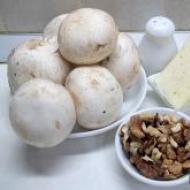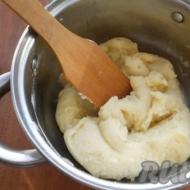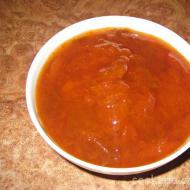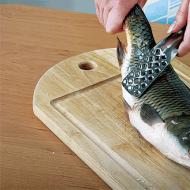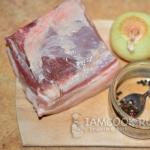
Frozen berries and fruits. How to properly freeze berries How to properly defrost strawberries from the freezer
I decided to devote a separate article to freezing berries, since this topic is especially relevant now. I myself have frozen berries in different ways, I especially like it. But in addition to this method - in its own juice - sometimes it is required to prepare some dishes or simply to decorate cakes, fresh or frozen berries. But I wanted them to look fresh and not be watery or tasteless. And then one day I finally found a video on the Internet about how to properly freeze berries. This method seemed reliable to me, especially since competent people talked about it, and I tried it. The berries were indeed preserved perfectly - they did not lose their shape after defrosting and the taste was pleasing. Therefore, I will tell you how to freeze and a little about how to properly defrost berries before eating.
I freeze raspberries, cherries, and, in general, any berry that grows in our dacha using this method. Not fanatically, little by little, since we don’t have a huge freezer, the refrigerator has 3 drawers in the freezer. You also need to freeze vegetables and herbs. But everything is included, since I try to pack everything compactly.
Now in detail.
What you will need for this:
- disposable plates
- small square containers with lids
- plastic bags
- freezer with a temperature of -18-20 degrees
The berries can be washed in water with the addition of salt or vinegar (1 tablespoon of salt or vinegar per 1 liter of water). But this is optional. Why is this done - to get rid of various bugs and worms that are in the berry. And also in order to wash away various bacteria that come from the ground, with dust, with river water, which we most often water. It is not recommended to wash the berries under running water, as they may become deformed and will spread when defrosted.
After washing, place the berries on paper towels and dry them from water; we don’t need excess water in this matter. You can use a regular hairdryer with cold air for this. If water remains on the berry, ice crystals will form during freezing, which can ultimately damage the berry when defrosting.

Place dry, clean berries on disposable plates in one layer and cover with a second plate on top.


The height of this design is approximately 1.5 cm, so place one on top of the other in the freezer, which saves space. Leave in the freezer until the berries are completely frozen, about 3-4 hours.


We prepare containers of the same size in advance and insert plastic bags into them. We take out the frozen berries and pour them into a bag. In this case, the lid should close freely without squeezing the berries. Place in the freezer again for about 1-1.5 hours. Why this is needed, a neat cube of berries in a bag should freeze in a container.

We take the bags of berries out of the containers and put them like bricks in the freezer for storage.

How long to store frozen berries
At this temperature (-18-20 degrees), the berries can be stored for 8 to 12 months. If the temperature in your freezer is higher, then the berries can be stored for up to six months.
Here's how to properly freeze berries. Of course, you will have to spend some time, but we are doing this for our loved ones. I think it's worth it.
How to defrost berries correctly
2017, . All rights reserved.
Summer is already bearing fruit for us: strawberries have ripened, wild strawberries and the first garden raspberries have already appeared. Next in line are currants, gooseberries, and cherries. How to preserve a tasty harvest without losing a single vitamin and without crushing the fragile berries? In fact, there is only one option - to freeze.
What kind of berries should there be?
Berries need to be frozen as they ripen (if you have a garden), or when purchased. The fresher the berry that falls into your hands, the better. Do not try to freeze completely ripe berries - they will certainly “spread” and lose their shape. You need to capture the moment of harmony between ripeness and stability.
Freezing temperature
That the temperature most suitable for freezing ranges from minus 18 to minus 23 degrees. At temperatures of minus 18 and below, vegetables and fruits are frozen faster and more reliably and stored for 8 to 12 months - i.e. almost until next season.
You can freeze food at temperatures from 0 degrees to minus 8. However, keep in mind that such products should be stored for no more than three months.
Container for berries
Our goal is not just to freeze the berries, but also to preserve their appetizing appearance. After all, in winter we can decorate a variety of dishes and desserts with them. In order to maintain the shape of the berries, cellophane bags and small plastic containers with lids, which can be purchased in disposable tableware departments, are perfect.
Thanks to their rectangular shape, they fit very well into freezer spaces. But if the number of berries is alarmingly large, you can save a little freezer space by using plastic containers to shape plastic bags convenient for storage. It's very easy to do.
Place each bag, into which frozen berries have already been poured, into a rectangular plastic container and place in the freezer. Once the contents of the bag have frozen into a rectangular shape, the container can be released to be reused as a freezer mold. The resulting rectangular bags are placed quite compactly in the freezer.
Delicate berries - strawberries, raspberries and blackberries are best stored in containers. This way they will not wrinkle when frozen and will retain their shape when defrosted. Currants, cherries and gooseberries, as well as many others, can be frozen dry and stored in plastic bags.
You can grind the berries and freeze them as a puree. With or without sugar, it’s up to you.
Size matters
In the freezer, for ease of use, berries should be stored in a volume convenient for you. Which one is up to you to decide. Indeed, in one case you will have to count on winter compote for a family of 5 people, and in another - for dessert for one glamorous girl.
Why are such calculations important? The fact is that under no circumstances should you re-freeze food, which means you need to pack the frozen food in such a way that you can immediately use the entire contents of the bag or container. In addition, small portions are frozen and stored faster and with better quality.
What berries should I harvest?
An individual approach based on the tastes of your family is also important here. After all, you wouldn’t fill your entire freezer with green peas if no one eats them? Therefore, first, decide on the portion size and assortment and then proceed to this simple method of preparation.
Freezing strawberries
This berry can be frozen in several ways. If you need to preserve the whole strawberries, you need to first wash them, freeze them on a flat surface (you need to lay them in one layer), and then place them in a container and put them in the freezer.
Freezing currants
This healthy berry can be easily frozen dry, placed in containers or plastic bags, or in the form of puree - both with and without sugar (as you wish).
Freezing blueberries
The berries must be thoroughly washed and dried. Next, place in a plastic bag or plastic container and place in the freezer. You can grind blueberries with a little sugar.
Freezing cranberries
The sorted and washed cranberries should be dried on a terry towel, placed in a low container (try not to let the berries touch each other to avoid freezing) and placed in the freezer until completely frozen, then poured into dry containers. This healthy berry is also the most unpretentious in terms of storage. It can be preserved by simply adding some water even before the first frost. If the berries are whole and undamaged, you can not freeze them until spring. At the same time, which is typical, they do not lose their taste and healing properties.
It is possible to preserve summer aromas and vitamins not only in memory, but also in reality, if you have a modern refrigerator (or freezer) and a little time. Ordinary jam, of course, is wonderful, but still, you must admit, fresh berries are a completely different matter. You can say that nowadays you can buy anything you want in supermarkets, even in winter. This is true. But frozen berries from your own garden turn out to be many times healthier (and tastier!) than fresh strawberries, which we sell in January. Remember, these strawberries don’t even have a smell! So you should definitely try to freeze at least some berries: in winter, your family will appreciate your efforts.
What you need for freezing
To freeze, you don’t need much: berries, clean plastic containers of rectangular or square shape, a flat large tray, tap water, electricity and a good refrigerator. As for berries, you can freeze almost anything that grows in your garden or is sold on the market in the summer. It is best to freeze those berries that you cannot buy in the store: raspberries, gooseberries, strawberries, strawberries, mulberries, cherries, sweet cherries, bird cherries. Fans can risk freezing watermelon or melon (in pieces, of course). Before freezing, the berries must be sorted, washed and dried. Select the strongest, whole and ripe berries for freezing. They should be washed with warm water without excessive mechanical impact, so as not to damage them. Opinions are divided regarding the stalks, seeds and twigs: some believe that with all this the berries will be “more alive”. Others remove everything unnecessary, leaving only the berries.
How to freeze

The freezer is set to maximum cold about two hours before the freezing procedure begins. For freezing, it is best to set the temperature to –20° C. Very juicy berries, such as strawberries and raspberries, are placed on a tray and placed in the freezer for two to four hours. During this time, the berries are sufficiently frozen, and they can be safely poured into containers, sent for long-term storage deep into the freezer. By the way, you can store frozen berries for a whole year, until the next harvest. Currants, cherries and gooseberries are not so delicate, and they can be poured into containers immediately and placed in the freezer in this form. Some people use plastic bags to freeze berries, but the berries in them are often damaged, leak juice and freeze into a monolithic conglomerate. When thawed, they lose their shape and juice. Therefore, bags can only be used for berries with strong skin or pre-frozen ones. But in general, containers are more convenient: they are durable, can be of any size, and their square or rectangular shape allows you to use the freezer space with maximum benefit. It is very convenient if the containers are labeled: so you can quickly understand what is frozen in them and when.

You need to defrost the berries in the refrigerator. This method takes the longest, but allows the berries to maintain their excellent appearance. You can use frozen berries for compotes, jelly, cocktails, decorating desserts, and preparing filling for pies.
The value of frozen berries and fruits
- When properly frozen and storage conditions are met, frozen berries and fruits almost always retain their natural taste and aroma.
- The nutritional value of berries and fruits is reduced slightly.
- Freezing does not affect the content of water-soluble vitamins in berries and fruits.
- Vitamin C in frozen berries and fruits is only slightly reduced.
- When comparing frozen berries and fruits with fresh, but not seasonal ones (for example, strawberries in winter, sold in large supermarkets), the nutritional value will be in favor of frozen ones.
- Frozen berries and fruits are an excellent opportunity for a housewife to please her family and friends with a delicious vitamin menu during a period when there is a risk of vitamin deficiency.
- Almost all berries that are considered seasonal are frozen - apricots, cherry plums, lingonberries, grapes, cherries, blueberries, blackberries, strawberries, strawberries, cranberries, viburnum, gooseberries, raspberries, cloudberries, sea buckthorn, rowan, currants, plums, mulberries (mulberry), blueberry, bird cherry. Fruits that can be frozen are apples and pears. You can also use watermelons and melons for freezing. Therefore, from a fairly wide assortment, through sampling, you can choose those fruits that will best satisfy your needs.
Basic requirements for berries and fruits
- Berries and fruits that will be further frozen must be ripe. In some cases, if culinary processing is planned after defrosting (cooking compotes, preparing pie fillings), berries and fruits at an initial stage of ripening are allowed.
- Overripe, damaged or rotten fruits are not allowed.
- The ideal berries for freezing are those that were picked no later than 2 hours before going into the freezer. They guarantee the high quality of the product. But, unfortunately, this rule can only be observed by those who have their own garden plot or dacha.
- All collected berries and fruits are sorted, if possible grouped by size and degree of ripeness.
- During the preparation process, berries and fruits are removed from unnecessary parts - stalks, leaves, seed nests. You should be careful with soft and delicate berries, such as raspberries, strawberries, blackberries and the like, so as not to damage the berries during mechanical processing. In some cases, such berries can be frozen with the stalks, and they can be cleaned after defrosting.
- Before freezing, berries and fruits are washed and then dried. I dry the washed berries on paper or cotton towels, placing them carefully over the entire area. To make drying faster, I can put the same clean towel on top of the berries, which will help absorb unnecessary moisture.
Methods for freezing berries and fruits
1. In bulk.
This is when prepared berries are laid out in a thin layer on a tray, a sieve, along the bottom of a wide container and placed in a chamber for pre-freezing. After 2-3 hours (or earlier, depending on the temperature your type of refrigerator maintains), the frozen berries are taken out and poured into plastic bags or sealed containers for further storage in the freezer.
In this way you need to freeze berries that can “leave juice”. If you freeze them in a bag at the same time, there is a chance that they will “stick together” and lose their appearance.
2. Mass freezing.
In this case, a portion of berries or fruits is placed in a bag or container and frozen. This option is suitable for all types of currants, rowan berries, blueberries, cranberries, gooseberries, apricots, cherries and other fairly hard berries.
3. Freezing berries in sugar.
Before freezing, berries and granulated sugar are placed in a hermetically sealed container in layers. After this, the container is placed in the freezer for freezing and storage.
In order for frozen berries and fruits to take up less space, they are stored mainly in briquettes or plastic bags.
It is very easy to form rectangular briquettes - when frozen, the products in the bag are placed in special molds. You can use cut juice bags and food storage containers as forms. After freezing, the formed briquette is simply removed from the mold.
Rules for storing frozen berries and fruits.
For frozen berries and fruits, it is advisable to use a separate drawer in the freezer. Then you will be sure that your “vitamin” reserves will not acquire the smell of nearby sea fish or herbs.
For the same purpose, each portion of the product must be hermetically packaged - either in special containers with lids, or in a tied bag. Also, poorly packaged frozen berries and fruits can release moisture, which will condense on the walls of the freezer. And this will lead to more frequent shutdowns of the refrigeration unit to defrost the walls. In this case, you will need to think about where to store the food. In winter, you can simply take the freezer box out onto the balcony or any other cold place. If this is not possible, then try wrapping the freezer box with a woolen blanket, which will keep the temperature low.
The ideal packaging for berries and fruits would be portions designed for one-time use, and on each portion you can attach a label with the date of packaging and its contents. This will allow you to better navigate your inventory. The shelf life of most berries and fruits in the freezer is 10-12 months.
Defrosting berries and fruits
Berries and fruits can be used frozen - for example, for compotes and jelly (and I also use undefrosted berries for filling pies, dumplings and pies, then there is less juice and it’s easier to cook). And also for other purposes we need to defrost our products. And here it is important to follow certain rules.
Defrosting in the microwave:
+ it's fast enough;
- a large amount of juice and beneficial properties are lost.
Defrosting at room temperature:
+ average defrosting speed, 2-3 hours;
- the rate of loss of vitamin C increases, the growth of microflora accelerates (not always favorable), the loss of a large amount of juice.
Defrosting on the bottom shelves of the refrigerator:
+ maximum preservation of beneficial properties;
- a fairly long process, at a temperature of 4°C it will take 5-8 hours.
If you do everything correctly, you will be guaranteed the taste of fresh berries and fruits during the cold season!
Based on materials from "Stream UA"
Sunny summer gives us a long-awaited vacation, hot beaches and the incomparable taste of aromatic berries and fruits. Juicy strawberries, ripe cherries, juicy peaches and apples give the human body energy and vitamins. These berries and fruits beckon, exuding an incomparable aroma, and it is simply impossible to pass them by.
Unfortunately, the fruit and berry season in our country passes too quickly, and we do not have time to get enough of the taste and aroma of these wonderful fruits. They come to mind especially often in rainy autumn and early spring, when our body so desperately needs vitamins. Don’t worry: all the benefits and taste of berries and fruits can be felt even in winter, it’s just important to learn how to store them correctly.
Berries and fruits are perishable products, and the only way to preserve them without losing their taste and beneficial qualities is freezing. In the old days, when large refrigerators and freezers were a luxury item, most housewives canned or dried fruits for the winter. Today there is no need for this: modern refrigerators allow you to freeze at least one tray of healthy fruits.
Do frozen berries and fruits retain their value?
- Proper freezing and compliance with storage conditions allow berries and fruits to preserve not only their appearance, but also their natural taste.
- The reduction in the nutritional value of frozen fruits is not significant.
- Water-soluble vitamins contained in berries and fruits practically do not disappear.
- When frozen, the decrease in the content of beneficial vitamin C in fruits is very insignificant.
- Comparing frozen garden fruits with “fresh” ones sold in supermarkets in winter, experts concluded: frozen fruits are much more valuable than those grown in greenhouses.
- During periods of vitamin deficiency and exacerbation of viral diseases, frozen fruits are simply a salvation for any housewife. By adding berries and fruits to the daily menu, she will be able to provide not only a tasty, but also a vitamin-rich menu for her household.
- Almost all seasonal fruits and berries are suitable for freezing: wild strawberries, strawberries, viburnum, cranberries, raspberries, cloudberries, gooseberries, currants, rowan berries, sea buckthorn, mulberries, cherry plums, apricots, grapes, lingonberries, bird cherry, blueberries, blackberries and plums. Apples, pears, watermelons and melons are also suitable for freezing. The range of fruits that can be frozen is quite large, so each family can choose their favorite fruits and berries for winter storage.
However, freezing fruits does not mean just throwing them in the freezer and forgetting. There are several rules for the preliminary preparation and storage of frozen berries and fruits.
What fruits should be like for freezing?
- The ripeness of berries and fruits is one of the main indicators when freezing. If fruits are harvested directly for consumption, they must be at the best degree of ripeness. If berries and fruits are frozen for preparing compotes or fillings for pies, you can use unripe fruits.
- In any case, using overripe or rotten fruits for freezing is unacceptable.
- Ideally, fruits to be frozen should be harvested just before they are placed in the freezer. With this method, the highest quality of the frozen product is guaranteed. However, this rule can only be observed by owners of garden plots whose dacha farms have long been adapted for harvesting for future use.
- All fruits should be sorted, if possible according to size and degree of ripeness.
- The stalks, leaves and seed nests of fruits are subject to mandatory removal. When processing raspberries, strawberries and blackberries, care should be taken not to damage the delicate pulp of these berries. Sometimes freezing berries with stalks is allowed.
Well, the berries and fruits are ready to go into the freezer. What's next?
Some ways to freeze fruits
- It is better to freeze berries and fruits that may release juice in bulk. To do this, pre-prepared fruits are laid out in an even layer on the bottom of a tray, sieve or other wide container and placed in the freezer until completely frozen. After this, the fruits can be placed in plastic bags or containers. This way, especially delicate berries and fruits will not stick together and will not yield juice.
- For berries that nature has endowed with a dense shell, a mass freezing method is suitable. Currants, rowan berries, gooseberries, cranberries, cherries and cherries can be frozen immediately in bags or special containers.
- Freezing in sugar. This method involves laying berries in layers mixed with granulated sugar. After this, the hermetically sealed container is placed in the freezer.
- Freezing in sugar syrup. This method is similar to the previous one, but syrup is used instead of sugar. To prepare the syrup, take one part granulated sugar to two parts water, and the highest concentration of sugar leads to a slowdown in the freezing process. Water can be replaced with fruit juice.
- Freezing freshly prepared puree or juice from berries and fruits. In this case, the juice is prepared in any convenient way: using a juicer or a sieve. The finished juice is mixed with sugar and poured into containers.
When freezing berries and fruits, it is very important to rationally use the space in the freezer. Flat briquettes are the most ergonomic form for frozen fruits. It is not difficult to form such briquettes: you can use cardboard juice packaging, food containers and any flat pallets.
How to properly store frozen fruits
When freezing fruits and berries, we think about how they will delight us on cold winter evenings. But for this you still need to properly preserve them, following some rules.
- Frozen fruits and berries should be stored in a separate freezer drawer. Neighborhood with meat, fish and other products is unacceptable for these delicate fruits.
- Berries and fruits must be hermetically packaged, that is, placed in special containers or tight bags. If the packaging is loose, the fruits release moisture, which condenses on the walls of the freezer. And this, in turn, leads to more frequent shutdowns of the refrigerator to remove ice. In winter, frozen berries and fruits can be stored on the balcony, remembering to monitor the temperature level outside.
- Before freezing, it is better to package berries and fruits into single servings. Repeated freezing of the remaining fruits can harm their appearance and taste.
- The approximate shelf life of fruits in the freezer is 11-12 months. If there is a lot of frozen stock, you can attach a tag to each container with the date it was packed and the contents.
How to properly defrost berries and fruits before eating them
The preparations have long been made and are waiting in the wings when they get to the table. In some cases, it is not necessary to defrost berries and fruits, for example, to prepare compote, jelly, or to fill a pie. In general, for pies it is preferable to use unfrozen fruits: there is no juice from them that flows over the edges of the dough. But for direct consumption and for some other purposes, it is necessary to defrost the fruits, and at the same time it is necessary to remember some points.
- When defrosting berries and fruits in the microwave, time is saved significantly, but a lot of juice and most of the nutrients are lost.
- Natural defrosting at room temperature is a rather lengthy process, which leads not only to loss of juice, but also to the formation of unfavorable microflora.
- Gradual defrosting in the upper compartment of the refrigerator is the most optimal method, which ensures maximum preservation of vitamins and prevents the development of the proliferation of harmful flora. This process can take from 8 to 10 hours, so the fruits should be obtained in advance, for example, in the evening.
With proper storage and defrosting, the taste of summer berries and fruits will delight all family members all year round.
Frozen fruits can be used for a variety of purposes; here the housewife’s imagination is not limited by anything. They can be eaten simply as a dessert, cooked in compotes, added to baby food, used as ingredients in cocktails and refreshing drinks...
Save berries and fruits in the summer, and enjoy their juicy taste in the fall, winter and spring!

